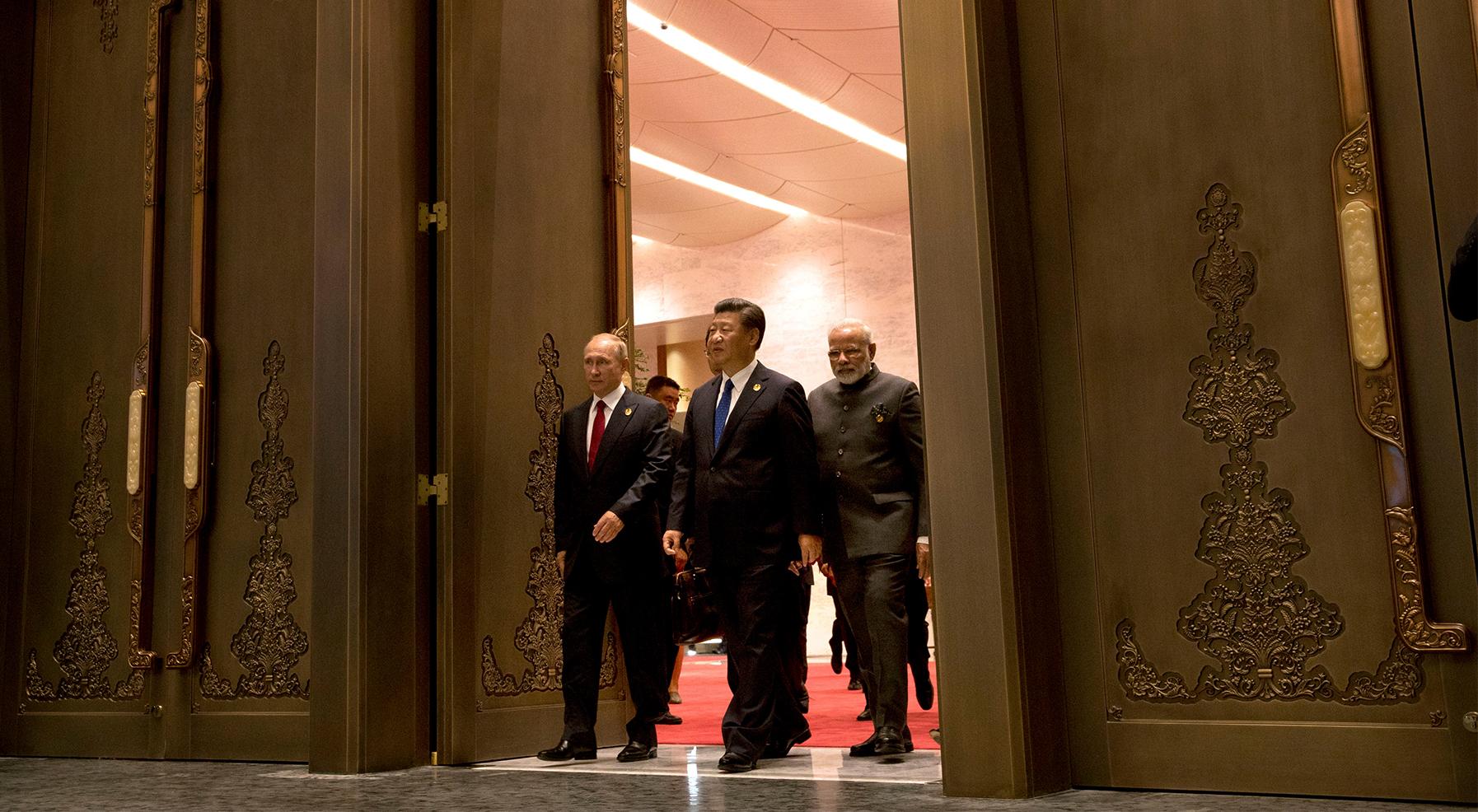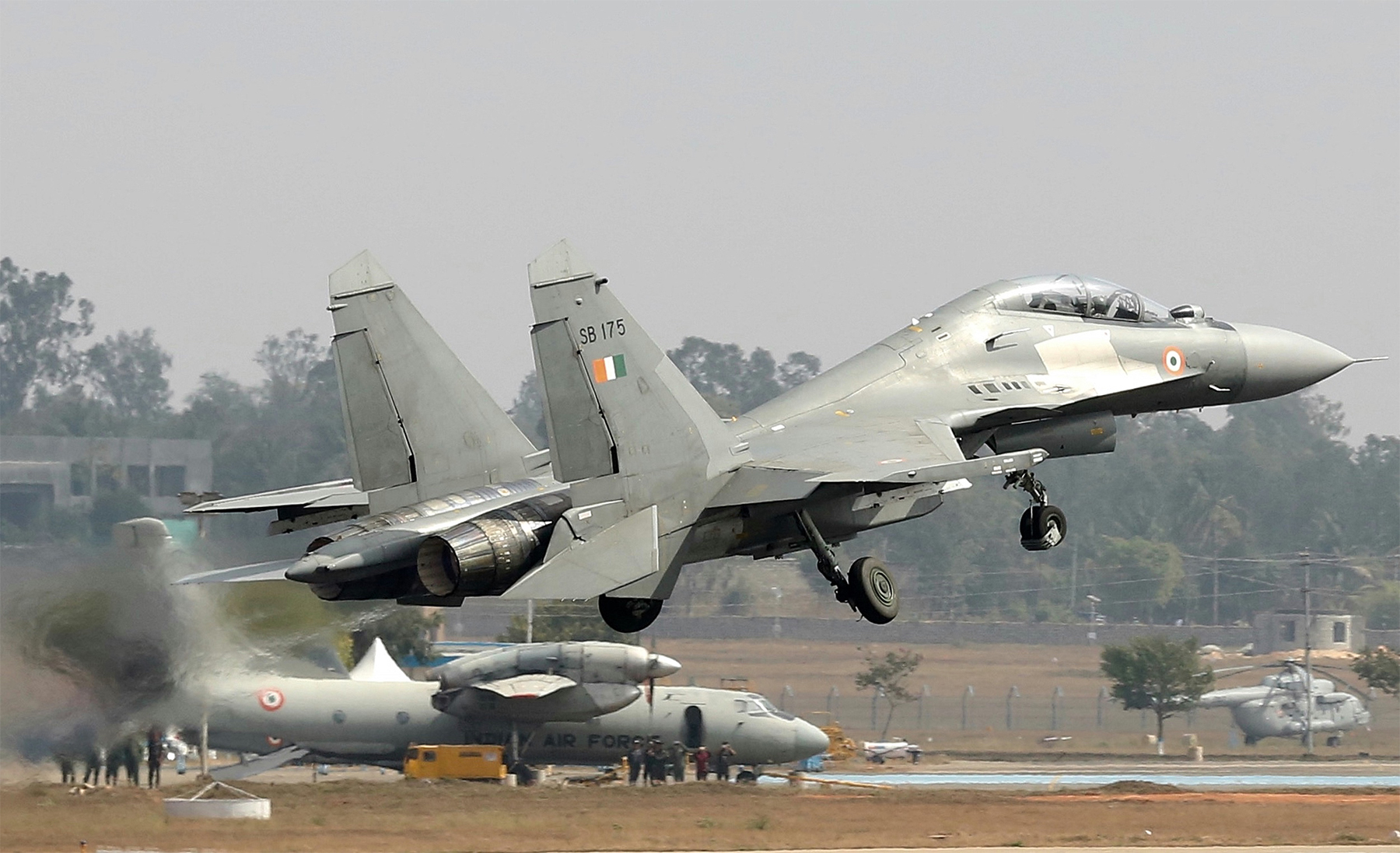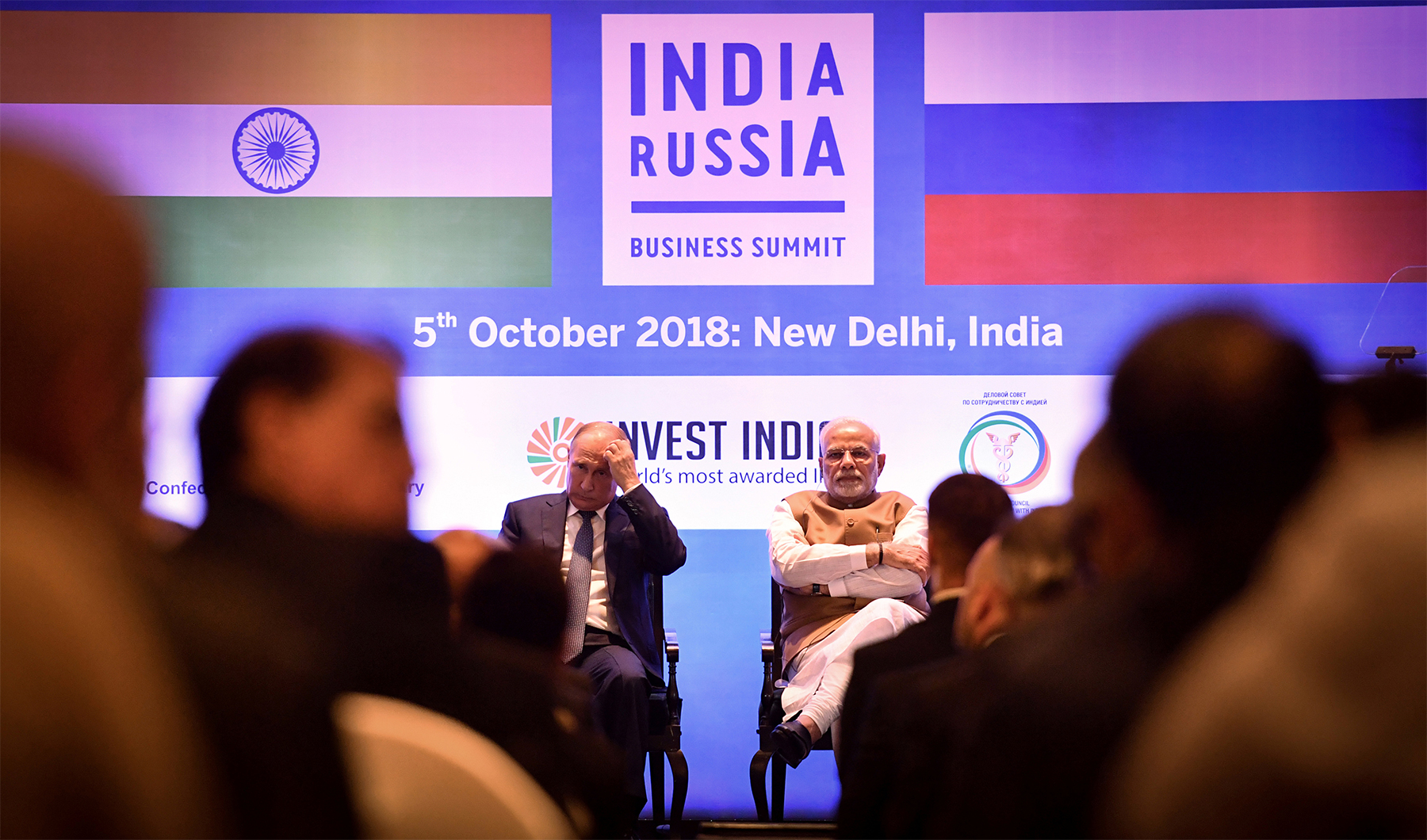Russia has been trying to turn towards the East for five years now, and the Indian vector traditionally gives hope. However, over time, the content of Russia-India relations is getting lost, and the pessimistic trends are causing more worries.
Russia-India relations are often labeled, and at times it seems hard to think of new epithets to describe the “unbreakable friendship” between the two countries. For many, the general context of “Russia's turn to the East” policy suggested that there had been more expectations around India for a breakthrough — a short word that became the keynote of Putin's new presidential term. Besides, the Russia-India summit that resulted in signing of a contract for the supply of S-400 Triumph missile system to India seemed to have proved the positive trend in relations between Russia and India. But no matter how hard Narendra Modi, the Prime Minister of India, was trying to remind about the need to diversify foreign trade and expand the range of issues on the agenda for fruitful cooperation in his speeches about the traditionally strong ties between Russia and India, there are still no signs of any breakthroughs in Russia-India relations.
Russia and India do have something to discuss, but the real problem is the lack of proper interest on both sides in striving to achieve the goals set. Foreign trade indicators definitely prove that. Trade with Russia hardly amounts to 2% of India’s total foreign trade. Russia is overtaken in this respect not only by China, the United States, and the EU but also by the ASEAN countries.
Security issues are a traditional area of mutual interest for both parties. That is why the successful deal on the purchase of S-400 Triumph system by India, concluded during Putin’s visit to India in October 2018, should become not only the sign of successful cooperation between Russia and India in the military-technical sphere (MTC), but also a reminder of the discussion held before the agreement was signed. The possibility of applying Countering America's Adversaries Through Sanctions Act (CAATSA) can seriously interfere with future military-technical cooperation between Russia and India. Moreover, 2+2 dialogue between India and the United States (negotiations between the foreign ministers and the ministers of defense of the United States and India), resulted in signing of the agreement giving India the right to purchase high-tech weapons from the US (COMCASA), which indicates that India intends to diversify its arms sources.
Russia’s current foreign policy paradigm cannot be blamed for narrow-mindedness. The idea of building a multipolar world meets both current trends in contemporary international relations and the national interests of Russia. The strategy of Russia’s turn to the East occurs to be successful, as well as the intensive development of Russia-India relations. However, the above-mentioned theses suggest that Russia needs not only new foreign policy concepts, but also competent goal setting and objective assessment of its resources — what we can offer to India and why we need it. It is likely that with this approach, Russia will fully turn to the East, and India, like many other Eastern partners, will show more interest towards Russia.
Russia has been trying to turn towards the East for five years now, and the Indian vector traditionally gives a lot of hope. However, over time, the content of Russia-India relations is getting lost, and the pessimistic trends are causing more worries.
Russia-India relations are often labeled, and at times it seems hard to think of new epithets to describe the “unbreakable friendship” between the two countries. For many, the general context of “Russia's turn to the East” policy suggested that there had been more expectations around India for a breakthrough — a short word that became the keynote of Putin's new presidential term. Also, the Russia-India summit that resulted in signing of a contract for the supply of S-400 Triumph missile system to India seemed to have proved the positive trend in relations between Russia and India. But no matter how hard Narendra Modi, the Prime Minister of India, was trying to remind about the need to diversify foreign trade and expand the range of issues on the agenda for fruitful cooperation in his speeches about the traditionally strong ties between Russia and India, there are still no signs of any breakthroughs in Russia-India relations.
To have at least some illusion of confidence in the future, it is worth looking back at the past, which helps not to forget about the goals achieved and the issues solved, as well as to set new benchmarks, especially when certain attempts are made to implement global reorientation in Russia's foreign policy. Let us try to review the latest initiatives on crucial tracks of Russia-India relations, assess their effectiveness, success, and failures.
The summits of the leaders of Russia and India have always been particularly important in relations between the two countries, underscoring the unique "chemistry" between Vladimir Putin and Indian Prime Minister Narendra Modi. Their discussions on strategic issues easily switch to benefits of yoga; when Modi was visiting Sochi on May 21, 2018, during the negotiations, he invited Putin to celebrate his birthday in Modi’s native state of Gujarat, which he formerly headed as Chief Minister. Although the Russian President managed to politely decline the offer of his colleague, the relationship between the leaders is a good prerequisite for achieving productive results.
During the summit meetings, the leaders discuss diversification of trade between the countries, development of cooperation in the energy sector, especially in nuclear power industry (Kudankulam Nuclear Power Station is a great example of Russia-India cooperation on nuclear energy, with joint construction of 6 new units), and cooperation in knowledge-based industries (aircraft manufacturing, automobile industry, and space exploration). They discuss possibilities for cooperation in infrastructure development, communications (deployment of ground stations for Russia’s GLONASS), prospects for the development of North-South Corridor infrastructure project, in particular, the development of Chabahar Port in Iran. Platforms are being created to coordinate common approaches, for example, the Strategic Economic Dialogue between the National Institution for Transforming India (NITI) Aayog and the Ministry of Economic Development of the Russian Federation.
All the initiatives listed above respond to the interests of both countries and, of course, are good in nature. Russia and India do have something to discuss, but the real problem is the lack of proper interest on both sides in striving to achieve the goals set. Trade indicators definitely prove that. Trade with Russia hardly amounts to 2% [1] of India’s total international trade. Russia is overtaken in this respect not only by China, the United States, and the EU but also by the ASEAN countries. In addition, the commodity structure of trade between the states does not suggest a prospect for a quick breakthrough — Russia exports mainly products of the extractive industries (hydrocarbons and diamonds) to India, and India is exporting chemical products (primarily pharmaceuticals and agricultural fertilizers) and textiles, tea and jewelry (rough diamonds of Yakutia polished in India) [2]. Russia should seriously think what it can offer to India; after all, India can buy all of the above not only from Russia.
Security issues are a traditional area of mutual interest for both parties. That is why the successful deal on the purchase of S-400 Triumph system by India, concluded during Putin’s visit to India in October 2018, should become not only the sign of successful cooperation between Russia and India in defense-related products area but also a reminder of the discussion held before the agreement was signed. The possibility of applying Countering America's Adversaries Through Sanctions Act (CAATSA) can seriously interfere with future military-technical cooperation between Russia and India. Moreover, 2+2 dialogue between India and the United States (negotiations between the foreign ministers and the ministers of defense of the United States and India), resulted in signing of the agreement giving India the right to purchase high-tech weapons from the US (COMCASA), which indicates that India intends to diversify its arms sources. At the moment, Russia’s share on the Indian arms market is about 60%, and this share will be deliberately lowered by the Indian government that is guided by purely economic considerations — India cannot remain dependent on armament supply from Russia, which once again should make Russia think what it can offer to the Indian side.
The characteristic feature of Russia-India relations is the consistent trend to support each other at various international platforms. The countries are mindful of each other, necessitating the attention to the multilateral format of cooperation between Russia and India.
SCO is one of the key alliances among the multilateral platforms where Russia and India are represented. In August 2018, the Peace Mission 2018 anti-terrorism military exercise held in Chelyabinsk Region gathered all SCO member states including, for the first time, India and Pakistan. Conducting this exercise with the participation of India and Pakistan could serve as an indicator of the positive dynamics in bilateral relations between the countries Russia had been promoting (already acting as an intermediary between the conflicting parties in the bipolar period). However, the events of September related to the policemen from the Jammu and Kashmir Police department being abducted and murdered by the Hizbul Mujahideen, as well as the terrorist attack in Pulwama on February 14, organized by the Jaish-e-Mohammad group, and the ensuing military clash between India and Pakistan suggest that during the period of the general parliamentary elections of 2019, the government of Narendra Modi cannot make any mistakes, which doesn’t augur well for the qualitative breakthrough in relations between India and Pakistan.
The work on the possible signing of the free trade zone agreement between India and the countries of the EAEU is a positive signal for Russia. Vietnam has already taken such a step, but the India interest towards Russia’s key project in the post-Soviet space will only strengthen the integration success already achieved.
The specifics of the BRICS quasi-integration workflow has not contributed to achieving tangible results since Russia announced turning to the East. However, in 2017, it was BRICS that served as a platform for communication between Narendra Modi, Indian Prime Minister, and Xi Jinping, General Secretary of the Central Committee of the CPC, on de-escalation of the situation on Doklam Plateau between the border troops of India and China, which at that time was still tense.
The meetings of the Foreign Ministers of Russia, India, and China failed to meet the high expectations entrusted to the format. Despite the fact that the statements made by the Foreign Ministers (Sergey Lavrov, Sushma Swaraj, and Wang Yi) demonstrate the coordinated approach of the countries on current international security and global economy issues, Chinese Foreign Minister Wang Yi refused to introduce the same format of meetings for the Defense Ministers of the triangle, avoids discussing freedom of navigation in the South China Sea, and is also not going to coordinate positions on the construction of the China-Pakistan economic corridor passing through Kashmir territory controlled by Pakistan. Thus, it becomes evident that the format of interaction between the three regional powers, created by Primakov, is certainly not underway.
In recent years, Russia and India have been actively developing cooperation in business areas, which in the future should become a catalyst in the diversification of trade between the countries. Russian business is quickly expanding its presence on the Indian market: in addition to the traditional sphere of the military-industrial complex, where Rostec State Corporation plays the key role, Russian companies affiliated with the energy sector (Rosneft Oil Company bought Essar Oil, the second largest oil refinery in India), transport and logistics, industrial production, trade and tourism are represented on the Indian market. Indian companies also opened production units in Russia specializing in pharmaceuticals, agricultural industry, gem-cutting, textile, and mining industries.
At the same time, despite the positive trends, the period under review was marked by an event, that proves that the representatives of business circles of the two countries are not interested in each other as much as it is desired. So, on August 14, 2018, at the initiative of the Indian side, a decision was announced to postpone the First Russia-India Economic Forum, which was to be held on August 19–20 in St. Petersburg, and the new date was not announced at that time.
The forum was supposed to gather representatives of the Ministry of Finance of the Russian Federation, the Central Bank of Russia, the Federal Tax Service of Russia, relevant federal agencies, representatives of the scientific community and business circles. Indian side expected the following participants: the leaders of the Reserve Bank of India (acting as the Central Bank of the country), the Ministry of Finance, the Securities and Exchange Board of India (SEBI), the National Investment and Infrastructure Fund, and Invest India Agency.
Nevertheless, the Forum was held in November 2018, but the main event of the business program of the Forum was only a plenary session with the participation of Maxim Oreshkin, Minister of Economic Development of the Russian Federation, and Rajiv Kumar, Vice-Chairman of the NITI Aayog. Roscongress Foundation was participating in the organization of the Forum together with the Ministry of Economic Development and the National Institution for Transforming India. There is no information about the representatives of the departments listed earlier participating in the Forum. So far, it can be stated with regret that potentially the largest event in the business sphere did not live up to all expectations. The postponement of the date of the forum and the small (compared to the expected) representativeness once again indicate the insufficient interest of the countries in each other regarding the genuine breakthrough in bilateral relations.
Russia’s current foreign policy paradigm cannot be blamed for narrow-mindedness. The idea of building a multipolar world meets both current trends in contemporary international relations and the national interests of Russia. The strategy of Russia’s turn to the East occurs to be successful, as well as the intensive development of Russia-India relations. However, the theses mentioned above suggest that Russia needs not only new foreign policy concepts, but also competent goal setting and objective assessment of its resources — what we can offer to India and why we need it. It is likely that with this approach, Russia will fully turn to the East, and India, like many other Eastern partners, will show more interest towards Russia.
1. Galischeva N.V. India's Foreign Trade in the 1950s – 2000s // MGIMO University, Economics, 2012, No.1 (22), p. 181-186.
2. Galischeva N.V. A Time Tested Union. India-Russia Economic Cooperation: Main Problems and Prospects. The end // Asia and Africa Today, 2015. - No. 5. - p.10-14.







